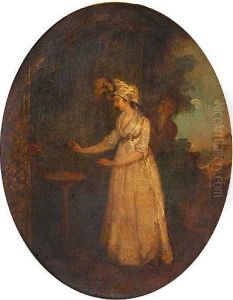Joseph Barney Paintings
Joseph Barney was an English artist known for his enamel paintings and miniatures. Born in 1753, Barney's artistic career spanned the late 18th and early 19th centuries, a period that witnessed significant changes in the art world due to the influence of Romanticism and the beginnings of the Industrial Revolution.
Barney initially trained as an enamel painter, a meticulous craft that involves fusing powdered glass to metal through high-temperature firing to create a durable, glossy finish. This technique was especially popular for portrait miniatures and decorative objects during the 18th century. Barney's skill in this medium earned him a reputation as a fine craftsman.
Throughout his career, Barney was associated with the production of decorative art objects, often collaborating with other artists and craftsmen. His works included a variety of subjects, from portraits to mythological and allegorical scenes. In addition to his work in enamel, he also produced watercolours and illustrations.
Despite the popularity of enamel painting in his time, this art form began to decline as new technologies and tastes emerged. However, Barney continued to work in this tradition, maintaining the high standards of craftsmanship associated with the medium. His works were appreciated for their detail, vibrant colours, and the technical skill required for their production.
Joseph Barney's contribution to the arts was recognized in his lifetime, and he was a respected figure among his contemporaries. His legacy lives on through his works, which are held in various collections and occasionally appear at auction. Barney's death in 1832 marked the end of a career that had successfully bridged the transition from the Rococo style of the early 18th century to the more expressive and individualistic art of the Romantic era.

